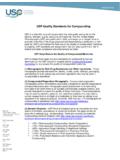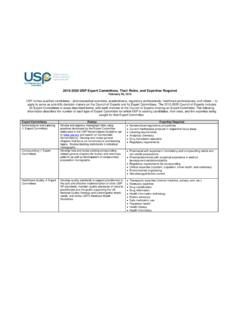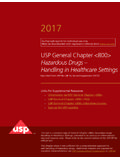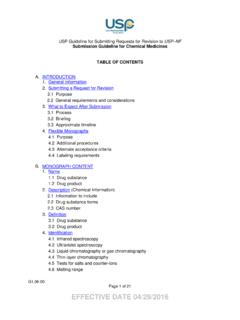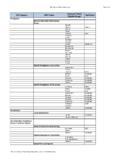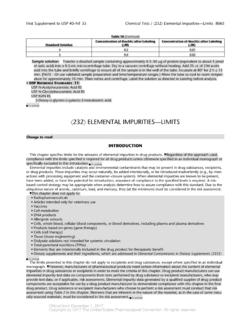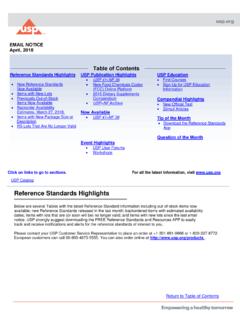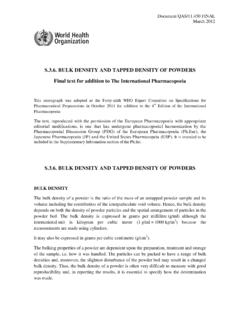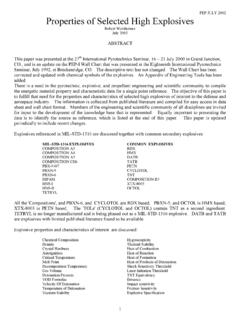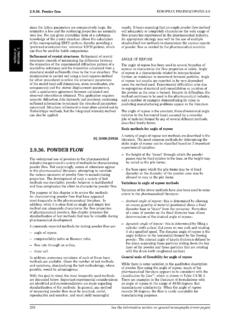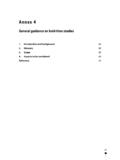Transcription of BULK DENSITY AND TAPPED DENSITY OF POWDERS
1 Stage 6 HarmonizationOfficial August 1, 2015 616 bulk DENSITY and TAPPED DENSITY of Powders1expression of results. For test samples having an apparent 616 bulk DENSITY ANDvolume between 50mL and 100mL, a 100-mL cylinderreadable to 1mL can be used; the volume of the cylinder isTAPPED DENSITY OF POWDERS specified in the expression of II Measurement in a VolumeterApparatus The apparatus (Figure 1) consists of a topChange to read:funnel fitted with a The funnel is mountedover a baffle box containing four glass baffle plates overwhich the powder slides and bounces as it passes. At thebottom of the baffle box is a funnel that collects the pow- bulk DENSITYder and allows it to pour into a cup of specified capacitymounted directly below it. The cup may be cylindricalThis general chapter has been harmonized with the cor-( volume with an inside diameter of texts of the European Pharmacopoeia and/or the ) or cubical ( (USP38) mL volumeJapanese Pharmacopoeia.)
2 UThe portion that is not harmo-with inside dimensions of ).nized is marked with symbols (uu) to specify this bulk DENSITY of a powder is the ratio of the mass ofan untapped powder sample and its volume including thecontribution of the interparticulate void volume. Hence, thebulk DENSITY depends on both the DENSITY of powder parti-cles and the spatial arrangement of particles in the powderbed. The bulk DENSITY is expressed in grams per mL (g/mL)although the international unit is kilograms per cubic meter(1g/mL = 1000kg/m3) because the measurements aremade using cylinders. It may also be expressed in gramsper cubic centimeter (g/cm3). The bulking properties of apowder are dependent upon the preparation, treatment,and storage of the sample, , how it was handled. Theparticles can be packed to have a range of bulk densities;however, the slightest disturbance of the powder bed mayresult in a changed bulk DENSITY .
3 Thus, the bulk DENSITY of apowder is often very difficult to measure with good repro-ducibility and, in reporting the results, it is essential tospecify how the determination was made. The bulk densityof a powder is determined by measuring the volume of aknown weight of powder sample, that may have beenFigure through a sieve, into a graduated cylinder (MethodI), or by measuring the mass of a known volume of powderthat has been passed through a volumeter into a cupProcedure Allow an excess of powder to flow through(Method II) or a measuring vessel (Method III).the apparatus into the sample receiving cup until it over-Method I and Method III are , using a minimum of 25cm3 of powder with thesquare cup and 35cm3 of powder with the cylindrical scrape excess powder from the top of the cup byMethod I Measurement in a Graduatedsmoothly moving the edge of the blade of a spatula per-Cylinderpendicular to and in contact with the top surface of thecup, taking care to keep the spatula perpendicular to pre-Procedure Pass a quantity of material sufficient tovent packing or removal of powder from the cup.
4 Removecomplete the test through a sieve with apertures greaterany material from the sides of the cup, and determine thethan or equal to , if necessary, to break up agglom-weight, M, of the powder to the nearest Calculateerates that may have formed during storage; this must bethe bulk DENSITY , in g/mL, by the formula:done gently to avoid changing the nature of the a dry graduated 250-mL cylinder (readable to 2mL)(M)/(V0)introduce, without compacting, approximately 100g oftest sample, M, weighed with accuracy. Carefullyin which V0 is the volume, in mL, of the cup. Record thelevel the powder without compacting, if necessary, andaverage of three determinations using three different pow-read the unsettled apparent volume (V0) to the nearestder unit. Calculate the bulk DENSITY in g/mL by theformula m/V0. Generally, replicate determinations are desir-Method III Measurement in a Vesselable for the determination of this property.
5 If the powderdensity is too low or too high, such that the test samplehas an untapped apparent volume of either more thanApparatus The apparatus consists of a 100-mL cylindri-250mL or less than 150mL, it is not possible to use 100gcal vessel of stainless steel with dimensions as specified inof powder sample. Therefore, a different amount of powderFigure to be selected as the test sample, such that its untap-1 The apparatus (the Scott Volumeter) conforms to the dimensions in ASTMped apparent volume is 150 250mL (apparent volumenB329 06(2012)n1S(USP38).greater than or equal to 60% of the total volume of thecylinder); the weight of the test sample is specified in the 2014 The United States Pharmacopeial ConventionAll Rights 6 Harmonization2 616 bulk DENSITY and TAPPED DENSITY of PowdersOfficial August 1, 2015 Figure or weight, the measuring cylinder or vessel ismechanically TAPPED , and volume or weight readings aretaken until little further volume or weight change is ob-served.
6 The mechanical tapping is achieved by raising thecylinder or vessel and allowing it to drop under its ownweight a specified distance by either of three methods asdescribed below. Devices that rotate the cylinder or vesselduring tapping may be preferred to minimize any possibleseparation of the mass during tapping IProcedure Pass a quantity of powder sufficient to com-plete the test through a sieve, if necessary, toApparatus The apparatus (Figure 3) consists of thebreak up agglomerates that may have formed during stor-following:age, and allow the obtained sample to flow freely into the A 250-mL graduated cylinder (readable to 2mL with ameasuring vessel until it overflows. Carefully scrape the ex-mass of 220 44 g)cess powder from the top of the vessel as described for A settling apparatus capable of producing, in 1 min,Method II.
7 Determine the weight (M0) of the powder to theeither nominally 250 15 taps from a height of 3 by subtraction of the previously determined2 mm, or nominally 300 15 taps from a height ofmass of the empty measuring vessel. Calculate the bulk14 2 mm. The support for the graduated cylinder, DENSITY (g/mL) by the formula M0/100, and record the av-with its holder, has a mass of 450 10 of three determinations using three different powderProcedure Proceed as described above for the of the bulk volume (V0). Secure the cylinder in theholder. Carry out 10, 500, and 1250 taps on the samepowder sample and read the corresponding volumes V10,Change to read:V500, and V1250 to the nearest graduated unit. If the differ-ence between V500 and V1250 is less than or equal to 2mL,V1250 is the TAPPED volume. If the difference between V500 TAPPED DENSITYand V1250 exceeds 2mL, repeat in increments such as 1250taps, until the difference between succeeding measure-The TAPPED DENSITY is an increased bulk DENSITY attainedments is less than or equal to 2mL.
8 Fewer taps may beafter mechanically tapping a container containing the pow-appropriate for some POWDERS , when validated. Calculateder sample. TAPPED DENSITY is obtained by mechanicallythe TAPPED DENSITY (g/mL) using the formula m/VF, in whichtapping a graduated measuring cylinder or vessel contain-VF is the final TAPPED volume. Generally, replicate determi-ing a powder sample. After observing the initial powder 2014 The United States Pharmacopeial ConventionAll Rights 6 HarmonizationOfficial August 1, 2015 616 bulk DENSITY and TAPPED DENSITY of Powders3nations are desirable for the determination of this OF POWDER COMPRESSIBILITYS pecify the drop height with the results. If it is not possibleto use a 100-g test sample, use a reduced amount and aBecause the interparticulate interactions influencing thesuitable 100-mL graduated cylinder (readable to 1mL)bulking properties of a powder are also the interactionsweighing 130 16 g and mounted on a holder weighingthat interfere with powder flow, a comparison of the bulk240 12 g.
9 NIf the difference between V500 and V1250 is lessand TAPPED densities can give a measure of the relativethan or equal to 1mL, V1250 is the TAPPED volume. If theimportance of these interactions in a given powder. Such adifference between V500 and V1250 exceeds 1mL, repeat incomparison is often used as an index of the ability of theincrements such as 1250 taps, until the difference betweenpowder to flow, for example the Compressibility Index orsucceeding measurements is less than or equal to Hausner Ratio as described (USP38) The modified test conditions are specified in theThe Compressibility Index and Hausner Ratio are measuresexpression of the the propensity of a powder to be compressed as de-scribed above. As such, they are measures of the powder sability to settle, and they permit an assessment of the rela-Method IItive importance of interparticulate interactions.
10 In a free-flowing powder, such interactions are less significant, andApparatus and Procedure Proceed as directed underthe bulk and TAPPED densities will be closer in value. ForMethod I except that the mechanical tester provides a fixedpoorer flowing materials, there are frequently greater in-drop of 3 at a nominal rate of 250 taps per interactions, and a greater difference betweenthe bulk and TAPPED densities will be observed. These dif-ferences are reflected in the Compressibility Index and theMethod IIIH ausner Index Calculate by the formula:Apparatus and Procedure Proceed as directed inMethod III Measurement in a Vessel for measuring bulk100(V0 - VF)/V0density using the measuring vessel equipped with the capshown in Figure 2. The measuring vessel with the cap isV0 = unsettled apparent volumelifted 50 60 times per min by the use of a suitable tappedVF = final TAPPED volumedensity tester.
